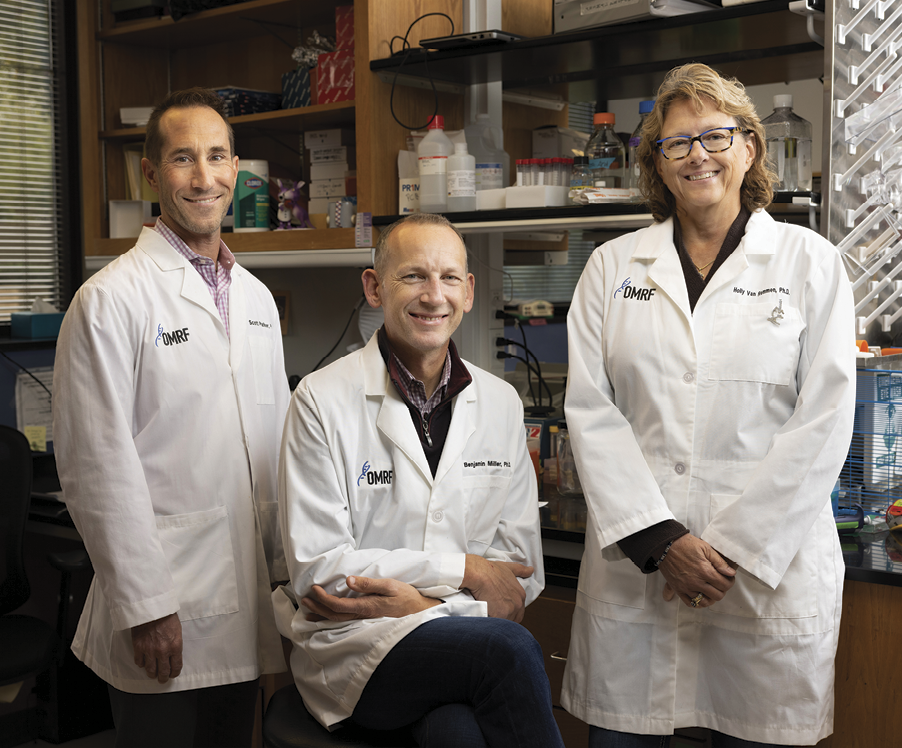And is that even the right question?
By Adam Cohen | Illustrations by Taylor Callery
The year was 2000. And the bet was simple enough.
Two biologists, each a leader in the field of aging research, had a fundamental difference of opinion. One believed that a human being alive at that very moment would reach the age of 150. The other did not.
So, they put their money where their mouths were.
Each deposited $150 in an investment fund. When a later study published in the scientific journal Nature strongly implied that the human lifespan had already reached its limits, the scientists doubled their bet.
The dispute would be settled no later than 2150. At that point, their investments likely would be worth many multiples of the original stakes. By then, it would also be clear who had won.
Either someone would have celebrated their 150th birthday, or they wouldn’t.
The principals would be long dead. But their closest living heirs (almost certainly yet to be born today) stand to make a pretty penny from the wager.
As of this writing, retired French nun Lucile Randon is the oldest person currently living. At 118 years, she still falls short of the standard set by Jeanne Calment. Also French, Calment enjoyed a glass of port, a cigarette and some chocolate most days. When she passed away in 1997, Calment is believed to have been 122, which most experts agree makes her the longest-tenured human ever.

We now are seeing a record number of centenarians. In 1950, when the Population Division of the United Nations began making such estimates, it put the number of people 100 and older worldwide at 23,000. By 2021, the figure had grown to more than half a million.
Still, most scientists who study aging do not believe this statistic equates to an ever-lengthening lifespan. “The risk of death at that point is so high that most people aren’t going to live much beyond the limits we see today,” Dr. S. Jay Olshansky, one of the bettors and a professor in the School of Public Health at the University of Illinois at Chicago, told The New York Times.
Even if you don’t have money riding on the answer, though, it seems hard not to be intrigued by the question of how many days a member of our species might, under perfect circumstances, live and breathe. Unless, that is, you are Dr. Benjamin Miller.
“How far we can push the maximal lifespan is not that interesting if it’s not met with quality years,” says Miller, who leads the Aging & Metabolism Research Program at the Oklahoma Medical Research Foundation. In his laboratory, he researches sarcopenia, the loss of muscle and function as we age. His work aims, he says, to “keep people healthy and independent for as long as possible.”
The optimal life trajectory, according to Miller, “is sort of a square.” With his index finger, he traces a vertical line in front of him, beginning at his waist and rising to his face. Then he moves his finger slowly in a flat line – “Here, you’re happy and healthy” – across the width of his body.
When it reaches his left shoulder, he plunges his finger straight down.
“And then you’re dead.”
_____________

Miller began his scientific career in exercise physiology, studying muscle. And while he is a devoted athlete – he reached the ranks of elite amateur cycling and still tries to ride at least a dozen hours a week – he soon became “bored” with his initial research focus: how to make muscles bigger.
“It became much more intriguing to me how to prevent the muscle from getting smaller,” he says. “That work is much more impactful, and it drew me into aging.”
Research on aging traces its roots to the 1930s, when scientists were studying malnutrition in rats. To their surprise, they realized the undernourished rodents lived longer than their well-fed counterparts. In the years since, researchers have replicated these findings in other species, including mice and fruit flies.
From a scientific perspective, caloric restriction seems like a tantalizing pathway for humans, save for two major problems. First, any type of experiment looms as nearly impossible from both moral and logistical perspectives. And, relatedly, we love to eat.
Nevertheless, says Miller, experiments in other model organisms offer signposts for the field. “We’re starting to look at drugs and other approaches the way we once studied caloric restriction.” Known as “mimetics” because of how they imitate certain aspects of the phenomenon, they include the diabetes treatment metformin and rapamycin, an immunosuppressive drug.

The OMRF researcher says he uses the time for two purposes: “To not think about science or to think about science.” Although he typically rides alone, he frequently keeps company with podcasts, usually on topics that have nothing to do with his day job. But almost as often, he says, “I will not listen to anything so that I can think about science and problem-solve.”
Miller has been biking since elementary school, when he first tagged along with his parents – avid cyclists both – on charity rides. While earning his master’s degree in kinesiology at the University of Wisconsin, he joined the cycling team, and that led to a long period as a competitive amateur cyclist, where he raced both on mountain and road bikes.
These days, he still competes occasionally, almost always in ultra-endurance races. This past summer, he finished third overall in a 24-hour mountain bike race. The event consisted of a 17-mile loop, which Miller managed to complete 11½ times, for a total of 196 miles. “That one beat me up,” he says in what undoubtedly is a tremendous understatement.
To celebrate his 50th birthday, he recently went on a 300-mile “bikepacking” trip in his native Wisconsin. In Oklahoma, he bikes to and from work each day with his wife, Bobbette, a physical therapist who treats patients in OMRF’s Multiple Sclerosis Center of Excellence.
Miller’s parents, now 75 and 77, both continue to ride regularly. He says he “can’t imagine” not following in their footsteps. Er, tire tracks.
To Miller, who’s received grants from the National Institute on Aging to study both metformin and rapamycin, alternative paths could provide insights while avoiding certain pitfalls. “It’s easier for humans to take a pill than calorically restrict for 40% every day for your entire life.” Similarly, he’s interested in the rise in popularity of dietary approaches like timed fasting, where people eat only between certain hours. “It could have caloric restriction-like effects, but it seems more feasible in humans.”
For many years, aging research existed only as a series of outcroppings from other fields. Over time, though, scientists realized that growing old represented the single largest risk factor for many of our most prevalent chronic ailments: dementia, cancer, arthritis, heart disease. They also saw that these conditions rarely arose in isolation, with multiple systems failing in rapid succession.
These developments have not gone unnoticed by wealthy givers. As the field has matured and taken on its own distinct identity, donors like Facebook founder Mark Zuckerberg and Saudi Arabia’s Crown Prince Mohammed bin Salman have begun using their immense fortunes to underwrite research projects. Still, their motives may not be purely philanthropic, says Miller.
“As they grow older, they start to understand they’re not immune to aging,” Miller says. “So, they’re dumping money into the idea of immortality.”
While the influx of funding stands to spur new discoveries, it also comes with potential perils. Miller worries that the disproportionate flow of dollars from monied donors could create health disparities, with potential breakthroughs benefiting only those who can afford to pay for them. And, he says, the rush of new cash invites the risk of charlatanism.
To the casual observer, it can be difficult to distinguish approaches that have a sound scientific basis from those that do not. Take, for example, cryonics, the idea that you can freeze people’s bodies (or at least parts of them) after death in hopes that scientists will one day be able to reanimate or replicate them.
A cottage industry has sprung up around this notion, capitalizing on people’s grief and desperation as they confront death, either their own or that of a loved one. According to a 2021 New York Times article, some companies are charging as much as $200,000 for experimental cryopreservation procedures. However, as Dr. Michael Hendricks, a neuroscientist at Montreal’s McGill University, wrote in the MIT Technology Review, “any suggestion that you can come back to life is simply snake oil … an abjectly false hope that is beyond the promise of technology.”
The concept of parabiosis – replacing an older person’s blood with blood from a young person – may sound just as implausible. Yet, says Miller, in animal models, scientists are now studying this approach to see if young blood plasma can restore old muscles’ ability to adapt to exercise. “If you consider blood transfusions and blood doping, I don’t think of this concept as far-fetched,” he says.
We will all one day fall prey to the effects of aging. One challenge for Miller and his colleagues is to balance the limits of science with our collective desire to cling to youth, vitality and, ultimately, life. Another is to manage our expectations.
_____________
As someone who studies age-related degeneration in the eye, Dr. Scott Plafker has long been cognizant of the toll time exacts on our bodies. But developments in his own life heightened that awareness.
“When your parents hit a certain age, you begin to see everything differently,” says the OMRF researcher. “You become so much more aware of their mortality and fragility. And your own.”
Like Miller, Plafker believes the goal of aging research “should be to extend healthspan, not lifespan.” That often means trying to hit singles – common-sensical strategies that might yield incremental improvements – rather than swinging for the fences with theoretically transformational approaches that lack firm evidentiary foundation or any realistic promise of advances.
Plafker’s work centers on using diet as a tool to mitigate the effects of aging and age-related disease. With a grant from the National Eye Institute, he recently completed a four-year project examining whether a compound that’s naturally produced in broccoli, cabbage, cauliflower and Brussels sprouts can protect the eyes as they age. Called sulforaphane, it had previously been shown to guard cells from stress and to have anti-cancer effects.
In mice that developed a condition resembling macular degeneration, Plafker’s research team fed the animals sulforaphane three times a week over a three-month period. They found that the rodents recovered function of their cones, photoreceptor cells in the retina that provide color vision and help us see fine details.
While the compound did not restore rods, photoreceptor cells that are sensitive to low light levels and are also lost in macular degeneration, Plafker was nevertheless encouraged by the results. “Sulforaphane is readily available in vegetables,” he says. “People can get it with ease, and they can get it without prescriptions or high costs.” This simple, easy-to- adopt approach represents precisely the sort of template researchers believe could prove most effective at enabling people to maintain their health as they get older.
Too often, says Plafker, we set the behavioral bar too high for ourselves, taking on fitness or dietary regimens so rigorous they’re unsustainable. “The key,” he says, “is to try to build habits.” That means finding something you like, or at least don’t mind, “and then developing it into a routine.”
When it comes to lengthening health spans, Miller sees a clear winning path: “As an aging researcher, there’s rarely a problem where I don’t think, ‘Oh, exercise could help that,’” he says. “The magnitude of the benefits produced by exercise is so large compared to other interventions that it seems like a no-brainer to me.”
Still, exercise is not a one-size-fits-all solution. For the most part, the people who are willing and able to exercise regularly already are. That means trying to find other answers for everyone else. Or, as Dr. Holly Van Remmen puts it, “Grandma’s probably not going to go to the gym three times a week.”
Van Remmen joined OMRF in 2013 and headed the foundation’s Aging & Metabolism Research Program until turning over the reins to Miller. But she is continuing her research, which, like Miller’s, centers on sarcopenia, the loss of muscle as we age.
She focuses on the cellular aspects of the process, working to develop a deeper understanding of what goes on at a molecular level. Over time, she hopes the work – hers and others’ – will open new therapeutic doors.
“Somebody needs to find an intervention or combination of interventions,” she says. “We’re not there yet, but we’re a lot closer than we were 20 years ago.”
_____________
In Miller’s own lab, that search is on. Currently, it’s targeting two drugs: metformin and rapamycin. Already approved by the U.S. Food and Drug Administration for other indications, both have also shown promise in curbing some biological effects of growing older.
“Pills aren’t going to accomplish all that exercise can, but they can be a nice first couple of steps,” Miller says. “They’re a way to reach those who won’t or can’t exercise.”
He’s now conducting a clinical study of the anti-aging effects of metformin, the world’s most prescribed diabetes drug. In a previous study, he found it blocked normal physiological gains from exercise. But based on other data from the work, he believes the drug might still aid less active people.
To test this hypothesis, he’s recruited volunteers aged 40 to 75 who have higher-than-normal blood sugar, a body mass above 30, or are not physically active. “Our goal is to help determine who may benefit from metformin and better target the treatment to slow the onset of chronic diseases,” he says.
With a new grant, he’ll also use rodents to study rapamycin, which doctors now prescribe to prevent rejection in organ transplants and as a therapy for certain cancers. He’ll examine whether, in older animals, the treatment might help muscles recover after injury or disuse.
He doesn’t expect either drug will prove a magic bullet that stops aging. “We have so much still to do, because these treatments are not well understood,” says Miller. Nevertheless, in the longer term, he hopes his research will lead to concrete advances.
“I’d like to reach a point where we can expand the health span,” he says. “Right now, it’s just a concept.” Down the road, he says, “it would be really great if we could actually do something about it.”
—
Read more from the Winter/Spring 2023 issue of Findings
In Good Company
Voices: Jamaica Potts Szeliga
Ask Dr. McEver: Terms and Conditions
School’s Out
Nothing But Net
Renaissance Man
Groundbreaker




